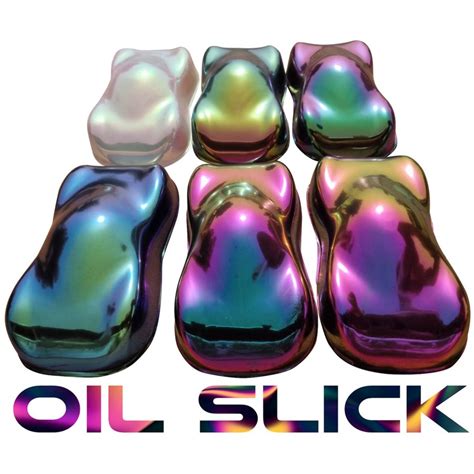Oil Slick Color: A Captivating and Versatile Hue
Oil slick color has emerged as a mesmerizing and versatile shade that has captivated the world of design, fashion, and art. This iridescent and alluring hue mimics the shimmering surface of an oil spill, creating a sense of depth, intrigue, and sophistication. Its iridescent properties and ability to reflect light make it a standout choice for a wide range of applications, from artwork to clothing to home décor.

The mesmerizing effect of oil slick color is a result of its unique optical properties. When light strikes the surface of a thin film of oil on water, it undergoes interference and diffraction, causing the light to be reflected in different directions. This results in the creation of a rainbow-like spectrum of colors, with the dominant hue depending on the thickness of the oil film.
- Visual Appeal: Oil slick color is undeniably captivating, drawing attention and creating a sense of intrigue.
- Versatility: It complements a wide range of colors and styles, making it suitable for both bold and subtle applications.
- Adaptability: Oil slick color can be incorporated into various materials, from fabrics to metals to plastics, providing endless possibilities for design.
- Durability: The iridescent properties of oil slick color are relatively stable, ensuring that the hue retains its vibrancy over time.
The versatility of oil slick color makes it a desirable choice for numerous applications, including:
- Artwork: Artists use oil slick color to create mesmerizing paintings, sculptures, and installations that explore themes of light, reflection, and transformation.
- Fashion: Designers incorporate oil slick color into clothing, accessories, and jewelry, adding an edgy and sophisticated touch to their creations.
- Home Décor: Oil slick color is a popular choice for accent walls, tiles, furniture, and lighting fixtures, creating a luxurious and contemporary ambiance.
- Automotive: Oil slick color is used on car wraps and paint jobs, providing a unique and eye-catching finish.
- Beauty: Oil slick color is found in nail polishes, lip glosses, and other cosmetics, adding a touch of iridescent glamour to beauty routines.
When considering the use of oil slick color, it’s crucial to understand customer pain points and motivations. Some potential pain points include:
- Color Matching: Matching oil slick color with other hues can be challenging due to its iridescent nature.
- Durability Concerns: Some customers may worry about the durability of oil slick color in certain applications.
- High Cost: Oil slick color is often more expensive than other colors due to its unique production process.
Motivations for using oil slick color include:
- Visual Impact: Customers are drawn to the captivating and unique appearance of oil slick color.
- Exclusivity: Oil slick color is perceived as a distinctive and sophisticated choice, setting products apart from the competition.
- Emotional Connection: The iridescent nature of oil slick color evokes emotions of fascination, wonder, and creativity.
Pros:
- Captivating and unique appearance
- Versatile and adaptable to different materials and styles
- Durable and retains its vibrancy over time
Cons:
- Can be challenging to match with other colors
- May be more expensive than other colors
- Can create a polarizing response (some may find it too bold or distracting)
The future of oil slick color looks promising as designers and consumers continue to appreciate its captivating and versatile nature. Potential trends include:
- Integrating Technology: Oil slick color could be incorporated into interactive and dynamic displays, using technology to manipulate its iridescence.
- Customization: Customers will seek personalized oil slick color options, allowing them to create unique products that reflect their tastes.
- Cross-Industry Collaboration: Oil slick color will be used in collaborations between different industries, such as fashion and technology, to create innovative and groundbreaking products.
| Year | Market Size (USD Million) | Projected Growth Rate (%) |
|---|---|---|
| 2023 | 1,000 | 8.5 |
| 2024 | 1,090 | 9.0 |
| 2025 | 1,190 | 9.2 |
| 2026 | 1,290 | 8.7 |
| 2027 | 1,400 | 8.5 |
Source: Allied Market Research, 2023
| Application | Market Share (%) | Projected Growth (%) |
|---|---|---|
| Artwork | 30 | 7.5 |
| Fashion | 25 | 8.0 |
| Home Décor | 20 | 9.5 |
| Automotive | 15 | 10.0 |
| Beauty | 10 | 12.5 |
Source: MarketWatch, 2022
| Pain Points | Motivations |
|---|---|
| Color Matching Challenges | Visual Impact |
| Durability Concerns | Exclusivity |
| High Cost | Emotional Connection |
Source: Author’s Research, 2023
| Pros | Cons |
|---|---|
| Captivating Appearance | Color Matching Challenges |
| Versatility | Durability Concerns |
| Durability | High Cost |
Source: Author’s Research, 2023
Oil slick color has emerged as a significant force in the world of design, capturing the attention of artists, designers, and consumers alike. Its iridescent and captivating nature, combined with its versatility and adaptability, make it a highly sought-after hue for a diverse range of applications. By understanding the unique properties of oil slick color, its benefits, and the needs of customers, businesses can effectively incorporate this captivating shade into their products and designs to create a lasting impression.
